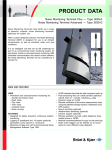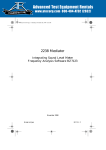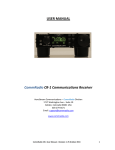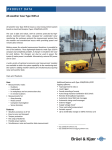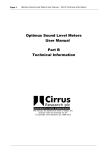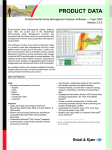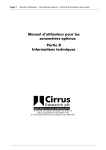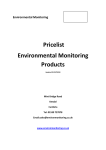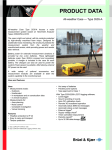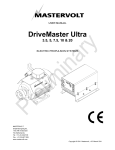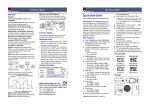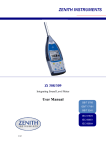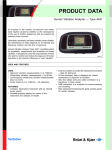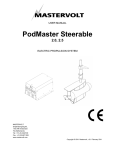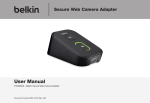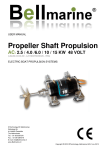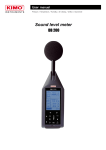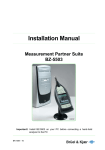Download Product Data - Brüel & Kjaer GmbH
Transcript
P R O D U C T D ATA Noise Monitoring Terminal Plus Type 3639-E Noise Monitoring Terminal Advanced Type 3639-G Noise Monitoring Terminals Type 3639 are a range of powerful, modular, noise monitoring terminals, optimised for outdoor use. With a custom-designed enclosure, the Noise Monitoring Terminal (NMT) is designed for use in all climatic environments, as well as industrial, urban and rural conditions. NMTs are intelligent units that can be left unattended as part of an environmental noise monitoring system for permanent, mobile or semi-permanent monitoring. With selectable communication and central control software, the Noise Monitoring Terminal can be controlled by a remote PC. Uses and Features Uses • Permanent and semi-permanent monitoring for: – Aircraft and airport noise – Road noise – City noise – Train noise – Industrial noise – Noise surveys Features • Designed for stable, long-term, continuous outdoor monitoring • Logging of broadband and 1/3-octave (optional) parameters every second, or half-second • Streaming of data over LAN to Environmental Noise Management Software Type 7843 and ANOMS • 40 GB industrial hard disk for safe, long-term backup • Post-processing that can create periodic statistical reports down to one minute, including LN data • Dynamic range of 110 dB • Remote verification of the entire measurement chain using the patented Charge Injection Calibration (CIC) • GPS support • Sound recording (optional) • Weather-data monitoring (optional) • Camera support (optional) • Remote operation via LAN, public telephone lines, mobile phone or GPRS • Modular hardware/software for easy on-site servicing • Noise event triggers can be defined on an hourly basis for more efficient noise detection Description Noise Monitoring Terminals Type 3639 are a range of powerful NMTs optimised for remote, unattended, environmental noise measurements, which: • Regularly check the calibration of the measurement chain, including the outdoor microphone • Measure noise with the outdoor microphone in compliance with IEC 61672 Class 1 specifications • Process noise and associated data • Store the results of up to several months of monitoring • Transmit data via RS–232, LAN, router, or modem, to a database on a central computer The NMT is a component of an unattended noise monitoring system. The main purpose of the system is to monitor environmental noise from airports, construction sites, industries and transport, and in areas either where noise is high (noise hot spots) or in quiet areas where noise is a major concern. A typical system, for example for airport-noise monitoring, would consist of several NMTs, a central computer system and a number of workstations. The NMT consists of a weatherproof cabinet containing a noise level analyzer and a battery, with a back plate for pole or wall mounting, and an outdoor microphone to be mounted on a mast, pole or tripod. Additional accessories such as a GPRS Router, GSM modem, weather station and a GPS satellite positioning system, can be added to the NMT (see Fig. 1). Fig. 1 Overview of the noise monitoring terminal and its accessories NMT PLUS Type 3639-E or NMT ADVANCED Type 3639-G Includes: – Wall/Pole Mounting Kit UA-1685 – Outdoor Microphone 4952 (NMT 3639-E) – Weatherproof Microphone 4184 (NMT 3639-G) – Battery QB-0065 – Battery Charger (built-in) – Auxiliary DC Cable AO-0649 – USB Cable AO-1480 (NMT 3639-E/G-200 series) – LAN Cable to Ext. PC AO-0679 – Auxiliary Mains Cable AN-0074 – Microphone Cable AO-0414-D-100 (NMT 3639-E) – Microphone Cable AO-0028-D-100 (NMT 3639-G) Options: – Weather Station MM-0256 (6 param.) – Weather Station MM-0316 (2 param.) – GPS Receiver ZZ-0249 (requires GPS Software BZ-7845) – PSTN Modem ZM-0070 – GSM Modem ZM-0071 – GPRS Router ZM-0073 – Environmental Noise Management System 3642 – Sound Calibrator 4231 – ANOMS – Event Analysis Software BZ-7844 (NMT 3639-E) – Battery QB-0065 – Battery Charger ZG-0453 (for charging QB-0065 outside the NMT) – Tripod UA-0587 for microphone – Tripod Adaptor DB-4024 – Tripod UA-1690 for NMT – Outdoor Camera WQ-2837 – Low-temp. Operation Modification – Solar Panels 2 Optional Setup: NMT PLUS 3639-E Outdoor Microphone 4952 GPS Receiver ZZ-0249 Microphone Cable AO-0414-D-100 Auxiliary DC Cable AO-0649 Radio Link (via modem) or cable Auxiliary Mains Cable AN-0074 Weather Station MM-0256 or MM-0316 Modem (PSTN or GSM) /GPRS Router NMT ADVANCED 3639-G Microphone Cable AO-0028-D-100 External DC Power Weatherproof Microphone 4184 External PC Auxiliary DC Cable AO-0649 Radio Link (via modem) or cable Auxiliary Mains Cable AN-0074 Camera WQ-2837 Tripod UA-1690 Tripod UA-0587 Modem (PSTN or GSM) /GPRS Router 050304/3 The NMT is controlled remotely by Environmental Noise Management Software Type 7843 (see BP 2100), ANOMS airport noise monitoring software or Noise Monitoring Software Type 7802 (see BP 1573), allowing remote setup, data and system status viewing, data download and analysis. An option allows the user or system integrator to implement control by third party software, through the documented instruction set included with the relevant configurations. The NMT is modular both in hardware and software, giving a very flexible solution that matches a wide range of needs. Software modules are pre-installed on the NMT and licenses can be moved from one NMT to another, if required, using Environmental Noise Management Software Type 7843. Using this control software, the NMT can be configured as needs arise, making the system very cost-effective. Configurations Standard configurations of the NMT Type 3639 (see Tables 1 and 2) include: • The support of two different microphones (Outdoor Microphone Type 4952 or Weatherproof Microphone Type 4184) • Remote operation by different central control software (Environmental Noise Management Software Type 7843, ANOMS airport noise monitoring software, Noise Monitoring Software Type 7802 or customerdefined third party software), not included with the NMT. Each software opens up different functionality in the NMT *. For example, Environmental Noise Management Software Type 7843 enables the Type 3639-E-200 series to: – Continually stream user-defined data to the Environmental Noise Management System’s server or ANOMS airport noise monitoring software’s server – Operate as a broadband terminal with no noise event detection, thus permitting a very cost-effective NMT both with growth potential and with the possibility for remote licensing for easy reconfiguration to allow event detection (Type 3639-E Event Analysis Option BZ-7844) • The support of different communication protocols: RS–232, PSTN and GSM, GPRS, LAN and WLAN, depending on the NMT configuration and the central control software (not included with the NMT). Some configurations include the required hardware for communication Table 1 Overview of the standard configurations of Noise Monitoring Terminal Plus Type 3639-E NMT Communication Protocols Supported (As Standard) Microphone Central Control Software Noise Monitoring Terminal Plus Type 3639-E 4952 Brüel & Kjær NMS Type 7802 RS–232, PSTN, GSM Noise Monitoring Terminal Plus Type 3639-E-001 including PSTN Modem ZM-0070 4952 Brüel & Kjær NMS Type 7802 RS–232, PSTN Noise Monitoring Terminal Plus Type 3639-E-002 including GSM Modem ZM-0071 4952 Brüel & Kjær NMS Type 7802 RS–232, GSM Noise Monitoring Terminal Plus Type 3639-E-200 for ENMS 4952 Brüel & Kjær ENMS Type 7843, ANOMS LAN, GPRS Noise Monitoring Terminal Plus Type 3639-E-203 for ENMS, with GPRS Router 4952 Brüel & Kjær ENMS Type 7843, ANOMS LAN, GPRS Noise Monitoring Terminal Plus Type 3639-E-300 for System Integrators 4952 Customer-defined software RS–232, PSTN, GSM Noise Monitoring Terminal Plus Type 3639-E-301 for System Integrators, with PSTN Modem 4952 Customer-defined software RS–232, PSTN Noise Monitoring Terminal Plus Type 3639-E-302 for System Integrators with GSM Modem 4952 Customer-defined software RS–232, GSM * See also Product Data for Type 7843, Type 7802 and the ANOMS Brochure. 3 Table 2 Overview of the standard configurations of Noise Monitoring Terminal Advanced Type 3639-G NMT Communication Protocols Supported (As Standard) Microphone Central Control Software Noise Monitoring Terminal Advanced Type 3639-G 4184 Brüel & Kjær NMS Type 7802 RS–232, PSTN, GSM Noise Monitoring Terminal Advanced Type 3639-G-001 including PSTN Modem ZM-0070 4184 Brüel & Kjær NMS Type 7802 RS–232, PSTN, Noise Monitoring Terminal Advanced Type 3639-G-002 including GSM Modem ZM-0071 4184 Brüel & Kjær NMS Type 7802 RS–232, GSM Noise Monitoring Terminal Advanced Type 3639-G-200 for ENMS 4184 Brüel & Kjær ENMS Type 7843, ANOMS LAN, GPRS Noise Monitoring Terminal Advanced Type 3639-G-203 for ENMS, with GPRS Router 4184 Brüel & Kjær ENMS Type 7843, ANOMS LAN, GPRS Noise Monitoring Terminal Advanced Type 3639-G-300 for System Integrators 4184 Customer-defined software RS–232, PSTN, GSM Noise Monitoring Terminal Advanced Type 3639-G-301 for System Integrators, with PSTN Modem 4184 Customer-defined software RS–232, PSTN Noise Monitoring Terminal Advanced Type 3639-G-302 for System Integrators with GSM Modem 4184 Customer-defined software RS–232, GSM Outdoor Microphone Type 4952 (Type 3639-E) Fig. 2 Outdoor Microphone Type 4952 with integrated coupling, fitted on the top of a water pipe The outdoor microphone is a major factor in ensuring that the NMT complies with IEC 61672 Class 1 requirements, with either 0 or 90 ° reference direction. It functions correctly under conditions of up to 96% relative humidity, and in ambient temperatures ranging from –30 to +55 °C. The precision condenser microphone is protected inside the acoustically optimised windscreen, which has an anti-bird spike fitted at the top. Construction is elegantly simple, ensuring longevity and low maintenance costs. The microphone can be mounted on standard 1″ water pipe, allowing stable mounting and secure cabling. A range of tripods and microphone mounting systems (for example, 4 m masts and hydraulic masts) are available from, or can be recommended by, Brüel & Kjær. During transport, the microphone can be safely placed inside the NMT cabinet. For more information, see Product Data BP 2099. 4 Weatherproof Microphone Unit Type 4184 (Type 3639-G) The weatherproof microphone is the ultimate outdoor microphone for permanent installation in all environmental conditions, while ensuring that the NMT complies with IEC 61672 Class 1 requirements. Fig. 3 Weatherproof Microphone Type 4184 with adaptor, fitted on the top of a water pipe It ensures accurate noise measurements in most humid and corrosive atmospheres with rain protection according to IEC 529 IP44, and operation all the way up to 100% RH. The microphone has excellent omnidirectional characteristics, allowing high accuracy with fixed orientation and less dependency on the operator’s expertise. The CIC function is complemented by a built-in test sound source (at 1 kHz) for actual calibration. For more information see Product Data BP 0741. Environmental Protection Fig. 4 Noise Monitoring Terminal Type 3639-E/ G – the electronics inside the NMT are well protected The NMT has been specifically designed to operate unattended in inhospitable environments, protecting the contents from weather and unwanted interruptions due to tampering, vandalism, theft, etc. All equipment is protected inside two interlocking cabinets. This dual cabinet construction ensures optimal protection of the equipment, while securing a growth path for future NMT solutions from Brüel & Kjær. A low-temperature protection kit is available for continuous operation of the NMT under extreme weather conditions* when running with mains power supply. The NMT also includes a watchdog function that ensures that, in the rare event of the NMT not operating (such as loss of power), it automatically restarts and continues measuring. The robust, durable, weatherproof cabinet includes a kit for fastening the cabinet to a wall, a box-sectioned or tubular mast, a lamp post or similar (diameter 40 – 200 mm, more if required) and the door seals the cabinet from the outside environment and helps prevent tampering. The cabinet is wellprotected by a weatherproof locking mechanism on the door, and a padlock can be mounted for security. The NMT also sends a signal to the remote software when the door is open, allowing unauthorised intrusion to be detected and recorded. In addition, protection is provided for cabling to reduce the risk of tampering or accidental damage. The system includes one or two batteries for independent operation, and as a backup in the event of power loss. It is possible to change the battery during operation for ease of maintenance and increased independence. The batteries are charged whenever external AC or DC is applied to the NMT and charging the batteries completely will take up to 24 hours. Brüel & Kjær can supply External Charger ZG-0453 for charging the batteries, once they have been removed from the NMT. The batteries can be fully charged in ten hours and one charger is needed per battery. * Contact your local Brüel & Kjær representative for more information. 5 The NMT can be powered from a variety of sources, such as solar panels connected through the DC supply input. An external UPS can be connected through the DC supply input. The cabinet also includes a mains outlet and cable for peripheral equipment that can be powered from the NMT. For example, a laptop can be powered from the NMT for setting up the NMT locally. A 10 m microphone cable is included to ensure that the outdoor microphone and the cabinet can both be positioned in the correct acoustical location, while being conveniently and securely mounted. Due to the clever design of the NMT, it is easy to add new accessories, for example, a GPS unit, even after the installation of the NMT on a wall or a pole. Noise Monitoring and Analysis Noise monitoring and analysis is performed by Noise Level Analyzer Type 4441 and System Controller UL-0235. The Noise Level Analyzer measures data coming from the outdoor microphone and this data is logged onto the System Controller. The NMT can be calibrated using Sound Calibrator Type 4231. In addition, the system has built-in CIC allowing automatic routine electrical checks to detect changes and faults in the system. CIC is a patented technique used for remotely monitoring the entire measurement setup including the microphone, preamplifier and connecting cable. The NMT can initiate up to four automatic, routine system checks per day at user-specified times, storing results for later download and investigation. A built-in display showing the primary measurement parameters and setup information is included for servicing and type approval, it is only activated when the NMT cabinet door is open, reducing power consumption. The NMT complies with IEC 61672 Class 1 specifications and has a dynamic range of 110 dB. Broadband Measurements and Frequency Analysis The NMT performs all the broadband analyses needed for environmental noise measurements, measuring Leq, Lpeak, Lim, Linst, Lmax, and Lmin. All values can be calculated for different time and frequency weightings (see specifications). The NMT performs octave or 1/3-octave analyses at filter centre frequencies from 12.5 Hz to 20 kHz. It can also identify noise events, for example, to restrict the duration of frequency analysis to reduce memory usage, and monitor LAeq-based statistics (for Type 3639-E-200 series configurations; this requires a license for Event Analysis Software BZ-7844). Storage of Results in a Database The NMT stores data in a database on the System Controller. The standard capacity of the database is 40 GB, corresponding to an average of six months of storage time (depending on the remote control software used). The retention period can be set up for all data sets. The following parameters are stored: • Hourly reports – Statistical information for every whole hour including Total Leq, Distribution • Short reports – User-defined short reports for a period of 1 to 60 minutes calculating minimum values, maximum values, Leq and five user-defined LN values • Calibration reports – Automatically checks the calibration of the system four times a day using the patented CIC check and stores the information in the database The following is also stored (for Type 3639-E-200 series configurations, Event Analysis Software BZ-7844 is required): • Hourly reports – Extended to include Total Leq, Background Leq, Noise Event Leq • Noise events – Detects noise events from any user-defined trigger level and duration, and stores the information in a database. Event trigger level and duration settings can be set on an hourly basis, enabling 6 the events to be set-up in accordance with the natural daily variations in the residual (background) noise. For each event the following information is stored at ½ or 1 second intervals: – SPL and Leq values – 1/3-octave spectrum, PNL (Perceived Noise Level) and PNLT (Perceived Noise Level, Tone Corrected) values, according to ICAO Annex 16 – The sound file Furthermore, EPN dB (Effective Perceived Noise Level) of all the events according to ICAO Annex 16 is calculated and stored in the database. All results can be downloaded to the central server provided with the supported central software (such as Environmental Noise Management Software Type 7843) continuously, or viewed in real-time remotely over a LAN or GPRS connection. With Noise Monitoring Software Type 7802, results can be downloaded via the optional modems to supported central software at a user-defined time interval, for example, once per day. Sound Recording Noise events can be recorded for later analysis or source identification (for Type 3639-A-, -B- or -E-200 series configurations, Event Analysis Software BZ-7844 is required). The files are stored as a compressed file (MP3) reducing the time and load spent on downloading data from the NMT. Alternatively, the recordings can be stored as high-fidelity wav files for post-processing, such as tone analysis using FFT in, for example, PULSE™ LabShop. If desired, sound recording can instead be done at regular, user-defined times. This enables the NMT to record sound at user-defined time intervals and durations for, for example, 1-minute sound recordings to be made at the start of every one hour in order to identify typical sound environments. Meteorological Data With optional Weather Station MM-0256 installed, temperature, windspeed and direction, relative humidity, air pressure and liquid precipitation can be monitored. Alternatively, a two-parameter Weather Station MM-0316 for windspeed and direction can be installed. The external weather station, mounted for example on a mast, is connected via a serial interface to the NMT’s System Controller. The station is delivered with a license to run the weather-data logging software needed to store the weather data in the NMT’s own database in the same manner as the noise measurements. GPS Geographical Positioning The NMT supports GPS so that, together with a standard commercial GPS receiver and antenna unit (for example, GPS Receiver with Antenna ZZ-0249), position (longitude, latitude and height) can be monitored and stored in the NMT’s own database in the same manner as the noise measurements. Camera Support The NMT can be configured to support an outdoor camera (for example, Outdoor Camera WQ-2837) so that pictures can be taken at 1 s intervals during noise events. You can set up the maximum number of pictures saved per event. This helps identify the causes or even individual offenders of the noise events and ensures that the amount of data stored is optimised to give enough detail while limiting the amount of data to be transferred and stored. Communication, Analysis and Reporting The NMT can communicate with a range of software, depending on the configuration selected, see Table 1 and Table 2. The ‘200’ series NMTs can be controlled remotely by Environmental Noise Management Software Type 7843 or ANOMS airport noise monitoring software, via standard internet-based protocols such as LAN or GPRS, as it is given an IP address. The NMT continually streams the data required by the ENM/ANOMS software user to the system server while storing it locally on the NMT as backup. Transmission of data is performed simultaneously with data logging, without data loss. Analysis and reporting of results are done using Environmental Noise Management Software Type 7843, or ANOMS airport noise monitoring 7 software, whose servers can be configured to allow a number of NMTs to be connected and a number of users to access the data simultaneously (see Product Data BP 2100). The ‘000’ series NMT configurations can be controlled remotely by Noise Monitoring Software Type 7802 via an RS–232 interface. Optionally, the NMT can be configured with PSTN or GSM modem communication. Again, transmission of data is performed simultaneously with data logging, without data loss and analysis and reporting of results are done using Noise Monitoring Software Type 7802 (see Product Data BP 1573). The ‘300’ series NMT configurations allow remote control of the NMT by customer-defined third party software, through the documented instruction set. Services Brüel & Kjær offers a wide range of support and services to ensure efficient and problem-free operation. These include a range of calibration services (accredited, traceable), repairs, conformance tests, warranty extensions, installation, training, help line and rental. Many of these services can be performed on-site, or locally, as well as at the factory. Annual and long-term service packs for the NMT and for an entire ENM or noise monitoring system are also available. 8 Compliance with Standards The CE marking is the manufacturer's declaration that the product meets the requirements of the applicable EU directives RCM mark indicates compliance with applicable ACMA technical standards – that is, for telecommunications, radio communications, EMC and EME WEEE mark indicates compliance with the EU WEEE Directive Safety EMC Emission EMC Immunity Temperature Humidity Mechanical Enclosure EN/IEC 61010–1 and ANSI/UL 61010-1: Safety requirements for electrical equipment for measurement, control and laboratory use. EN/IEC 61000–6–3: Generic emission standard for residential, commercial and light industrial environments. EN/IEC 61000–6–4: Generic emission standard for industrial environments. CISPR 22: Radio disturbance characteristics of information technology equipment. Class B Limits. EN/IEC 61000–6–1: Generic standards – Immunity for residential, commercial and light industrial environments. EN/IEC 61000–6–2: Generic standards – Immunity for industrial environments. EN/IEC 61000–4–4: Fast transient/burst immunity. Level 2 (± 1000 V) EN/IEC 61000–4–5: Surge immunity. Line-to-line: Level 1 (± 500 V). Line-to-ground: Level 3 (± 2000 V) Note: The above is guaranteed only: If Noise Monitoring Terminal Plus Type 3639-E is correctly assembled according to the instructions given in the User Manual When using accessories listed in this Product Data IEC 60068–2–1 & IEC 60068–2–2: Environmental Testing. Cold and Dry Heat. NMT Cabinet and Contents: Operating Temperature: –10 to +50 °C (14 to 122 °F) Operating Temperature with low-temperature protection kit: Down to –40 °C (–40 °F) Storage Temperature: –25 to +70 °C (–13 to +158 °F) IEC 60068–2–78: Damp Heat: 93% RH (non-condensing at 40 °C (104 °F)). Recovery time 2 to 4 hours Non-operating: IEC 60068–2–6: Vibration: 0.3 mm, 20 m/s2, 10 – 500 Hz IEC 60068–2–27: Shock: 500 m/s2 IEC 60068–2–29: Bump: 1000 bumps at 250 m/s2 IEC 60529: Protection provided by enclosures: IP 55 (without external cables); IP 44 (with external cables) Specifications – Noise Monitoring Terminal Plus Type 3639-E and Noise Monitoring Terminal Advanced Type 3639-G Specifications apply to all configurations unless otherwise stated STANDARDS Conforms with the following National and International Sound Level Meter Standards: • IEC 61672-1 (2002-05) Class 1 • IEC 60651 (1979) plus Amendment 1 (1993-02) and Amendment 2 (2000-10), Type 1 • IEC 60804 (2000-10), Type 1 • DIN 45657 (1997-07) • IEC 61260 (1995) Octave and 1/3-octave Bands Class 1 • ANSI S1.4 – 1983 plus ANSI S1.4A-1985 Amendment, Type 1 • ANSI S1.43 – 1997, Type 1 Conforms with the following National and International Filter Standards: • IEC 61260 (1995-07) plus Amendment 1 (2001-09), 1/3-octave Bands, Class 0 • ANSI S1.11-1986, 1/3-octave Bands, Order 3, Type 0-C • ANSI S1.11-2004, 1/3-octave Bands, Class 0 Note: The International IEC Standards are adopted as European standards by CENELEC. When this happens, the letters IEC are replaced with EN and the number is retained. Type 3639-G/3639-E also conforms to these EN Standards SELF-GENERATED NOISE LEVEL Typical A-weighted values at 23 °C for nominal microphone sensitivity: Type 3639-G (Microphone Type 4184) Microphone: 24.6 dB Electrical: 21.4 dB Total: 26.3 dB Type 3639-E (Microphone Type 4952) Microphone: 14.1 dB Electrical: 17.2 dB Total: 18.9 dB MEASURING RANGES (FOR SOUND LEVEL METER) Dynamic Range: From typical noise floor to max. level for a 1 kHz pure tone signal, A-weighted: Type 3639-G (Microphone Type 4184), Range: 26.3 – 142.0 dB Type 3639-E (Microphone Type 4952), Range: 18.9 – 134.0 dB Linear Operating Range: In accordance with IEC 61672, A-weighted, 1 kHz: Type 3639-G (Microphone Type 4184), Range: 34.1 – 142.0 dB Type 3639-E (Microphone Type 4952), Range: 29.8 – 134.0 dB Peak C Range: In accordance with IEC 61672: Type 3639-G (Microphone Type 4184), Range: 51.5 – 145.0 dB Type 3639-E (Microphone Type 4952), Range: 47.4 – 132.3 dB MEASURING RANGES (FOR FREQUENCY ANALYZER) Linear Operating Range: In accordance with IEC 61260: Type 3639-G (Microphone Type 4184), Range: ≤ 47.0 – 142.0 dB Type 3639-E (Microphone Type 4952), Range: ≤ 48.3 – 129.3 dB CORRECTION FILTERS For Microphone Types 4184 and 4952, Type 3639-G/3639-E is able to correct the frequency response to compensate for sound field (freefield or diffuse-field) and for Type 4952 0 ° (top) reference direction and 90 ° (side) reference direction 9 MEASUREMENTS Broadband Values: X = frequency weightings A and C, or A and Linear, or C and Linear (two weightings simultaneously) Y = time weightings Fast, Slow and Impulse (all simultaneously) LXeq LXpeak LXim LXYinst LXYmax/SPL LXYmin Spectrum Values*: X = frequency weightings A, C or Linear Y = time weightings Fast and Slow (two weightings simultaneously) LXYinst LXYmax LXYmin LXeq Equivalent Continuous Level (Leq): ‘I’-weighted value also selectable (LAIeq) 1/3-octave Frequency Range*: 12.5 Hz–20 kHz EVENTS* Settings: Hourly, user-defined on the following parameters: Detection: Separate event start/stop triggers Event Start Trigger: Leq or SPL with minimum threshold exceedance duration Event Stop Trigger: Leq or SPL with minimum threshold exceedance duration Sound Recording: Maximum duration, MP3 or WAV format DATA Data: Logging rate: ½ or 1 s Parameters: SPL and Leq, 1/3-octave spectrum, PNL and PNLT values BASIC STATISTICAL ANALYSES Hourly Reports: Statistical information including Total Leq, Distribution Short Reports: User-defined period of 1 to 60 minutes. Minimum values, maximum values, Leq, 5 user-defined LN values. Sound recording (Maximum duration, MP3 or WAV format, max. 20% of monitoring time) ADVANCED STATISTICAL ANALYSES Hourly Reports: Total Leq, Background Leq, Noise Event Leq PN dB (Perceived Noise Level) and EPN dB (Effective Perceived Noise Level) of all events according to ICAO Annex 16 OTHER DATA Calibration Reports: CIC system calibration checks up to four times a day Weather (Requires Optional Weather Station MM-0256): Wind speed, wind direction, temperature, relative humidity, liquid precipitation Weather (Requires Optional Weather Station MM-0316): Wind speed, wind direction * For Type 3639-E-200 series configurations, this requires a license for Event Analysis Software BZ-7844 to be installed from ENM Software Type 7843. 10 GPS (Requires Optional GPS Receiver/Antenna ZZ-0249): Latitude, longitude, altitude MEMORY CAPACITY The capacity of the database is dependent on the size of the hard disk. Standard configuration consists of a 40 GB hard disk giving at least six months storage space (90 days for Type 3639-E/G-200 series) Retention Time: User-defined INTERFACE Configuration dependent (see Tables 1 and 2) LAN, GPRS: Type 3639-E/G-200 series NMT Plus/Advanced for ENMS RS–232 Interface: using commercially available PSTN or GSM Modems: Type 3639-E/G NMT Plus/Advanced, Type 3639-E/G-000 series NMT Plus/Advanced, Type 3639-E/G-300 series NMT Plus/ Advanced for System Integrators WATCHDOG FUNCTION Ensures automatic restart of the NMT after failure/power loss CONTROL SOFTWARE Configuration dependent (see Table 1 and Table 2) Environmental Noise Management Software Type 7843: Type 3639-E/G-200 series NMT Plus/Advanced for ENMS or ANOMS ANOMS Noise Monitoring Software: Type 3639-E/G-200 series NMT Plus/Advanced for ENMS or ANOMS Noise Monitoring Software Type 7802: Type 3639-E/G-000 series NMT Plus/Advanced Prepared for Other Software: Type 3639-E/G-300 series NMT Plus/Advanced for System Integrators SOUND POWER LEVEL <36 dB (A) Lw DIMENSIONS AND WEIGHTS Weatherproof Cabinet: • Height: 829.2 mm (32.65″) • Width: 397.4 mm (15.65″) • Depth: 200.9 mm (7.91″) • Weight: 22.4 kg (49.3 lb) for NMT with one battery, 28.9 kg (63.7 lb) with two batteries • Mounting Kit: 7.5 kg (16.5 lb) POWER REQUIREMENTS Voltage: 110/220/240 V AC Frequency: 47.5 – 66.0 Hz Operates on external DC voltages between 12 – 24 V using the included External Aux. DC Cable AO-0649 Power: Heating option kit for NMT 3639 WU-0682 power consumption is 30 W per compartment (60 W total) Batteries: 1 × QB-0065 @ 12 V included, Max. 2 Typical Operating Time: 14 hours per battery, 24 hours with two batteries (charged when external AC or DC over 16 V applied) Ordering Information Type 3639-E Noise Monitoring Terminal Plus Type 3639-E-001 Noise Monitoring Terminal Plus, including PSTN ZM0070 Modem Type 3639-E-002 Noise Monitoring Terminal Plus, including GSM ZM0071 Modem Type 3639-E-200 Noise Monitoring Terminal Plus for ENMS and ANOMS Type 3639-E-203 Noise Monitoring Terminal Plus for ENMS and ANOMS, including GPRS Router Type 3639-E-300 Noise Monitoring Terminal Plus for System Integrators Type 3639-E-301 Noise Monitoring Terminal Plus for System Integrators, including PSTN Modem Type 3639-E-302 Noise Monitoring Terminal Plus for System Integrators, including GSM Modem Type 3639-G Noise Monitoring Terminal Advanced Type 3639-G-001 Noise Monitoring Terminal Advanced, including PSTN ZM-0070 Modem Type 3639-G-002 Noise Monitoring Terminal Advanced, including GSM ZM-0071 Modem Type 3639-G-200 Noise Monitoring Terminal Advanced for ENMS and ANOMS Type 3639-G-203 Noise Monitoring Terminal Advanced for ENMS and ANOMS, including GPRS Router Type 3639-G-300 Noise Monitoring Terminal Advanced for System Integrators Type 3639-G-301 Noise Monitoring Terminal Advanced for System Integrators, including PSTN Modem Type 3639-G-302 Noise Monitoring Terminal Plus for System Integrators, including GSM Modem Type 3639-E Noise Monitoring Terminal Plus includes the following accessories: Type 3639-G Noise Monitoring Terminal Advanced includes the following accessories: • • • • • • • • Type 4952: Outdoor Microphone QB-0065: Battery AO-0414-D-100: Microphone Extension Cable, 10 m (33 ft) AN-0074: Auxiliary Mains Cable UA-1685: Wall/Pole Mounting Kit AO-0649: External Aux. DC Cable AO-1480: USB cable* AO-1466: LAN cable, 1 m* • • • • • • • • Type 4184: Weatherproof Microphone Unit QB-0065: Battery AO-0028-D-100: Microphone Extension Cable, 10 m (33 ft) AN-0074: Auxiliary Mains Cable UA-1685: Wall/Pole Mounting Kit AO-0649: External Aux. DC Cable AO-1480: USB cable* AO-1466: LAN cable, 1 m* * 200 series NMTs only. Optional Accessories Type 4231 BZ-7844 QB-0065 ZG-0453 ZM-0070 ZM-0071 AO-0655 ZZ-0249 ZM-0073 MM-0256 MM-0316 UA-0587 UA-1690 DB-4024 Type 7843 Type 3642 WQ-2837 Sound Calibrator Event Analysis Software (for Type 3639-A, 3639-B or 3639-E NMTs) Battery Battery Charger for QB-0065 PSTN Modem GSM Modem GSM Antenna GPS Receiver GPRS Ethernet Router Weather Station (6 parameter) Weather Station (2 parameter) Tripod (for microphone) Tripod (for NMT) Tripod Adaptor Environmental Noise Management Software Environmental Noise Management System Outdoor Camera Products, Services and Accessories Quoted Upon Request • • • • • • • • • • • ANOMS Airport Noise Monitoring Software Masts Hydraulic and 4 m Tripods Solar panels Low-temperature Protection Kit Installation Support of NMT Maintenance Agreement Calibration Warranty Extension Help-line Support Rental 11 2014-06 BP 2098 – 14 Brüel & Kjær Sound & Vibration Measurement A/S DK-2850 Nærum · Denmark · Telephone: +45 77 41 20 00 · Fax: +45 45 80 14 05 www.bksv.com · [email protected] Local representatives and service organisations worldwide ËBP-2098---_Î Brüel & Kjær reserves the right to change specifications and accessories without notice. © Brüel & Kjær. All rights reserved.












